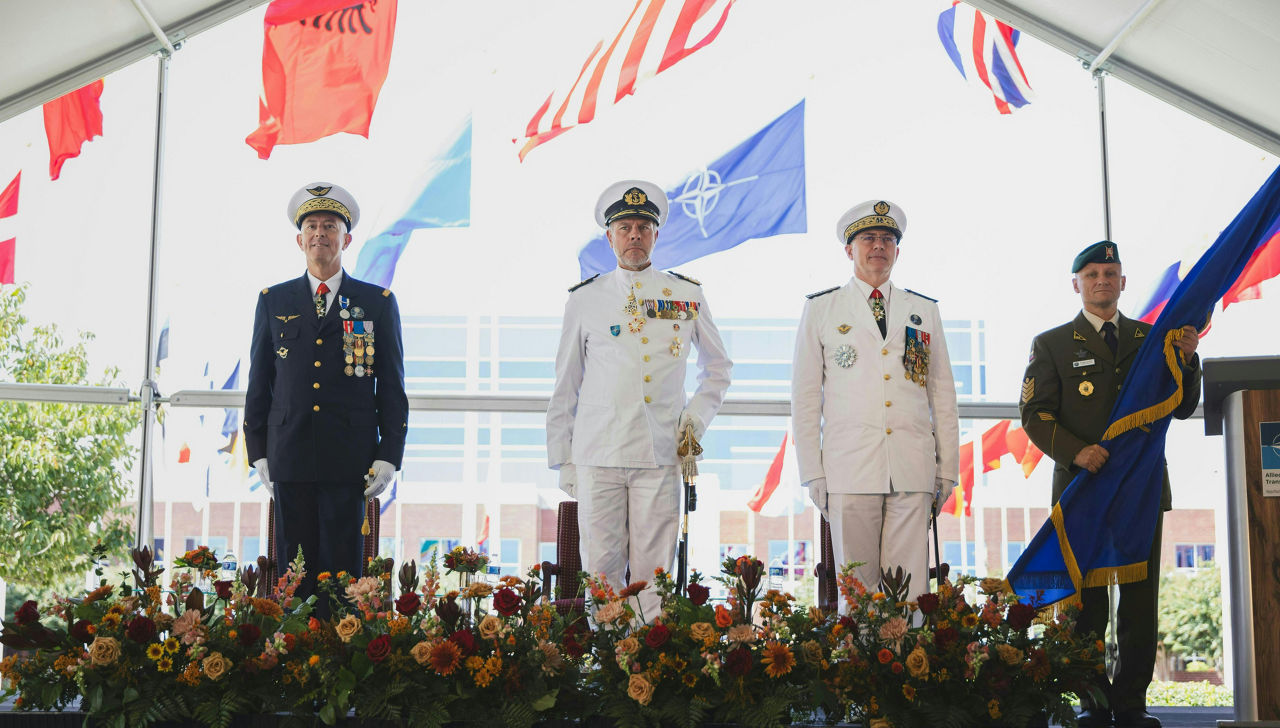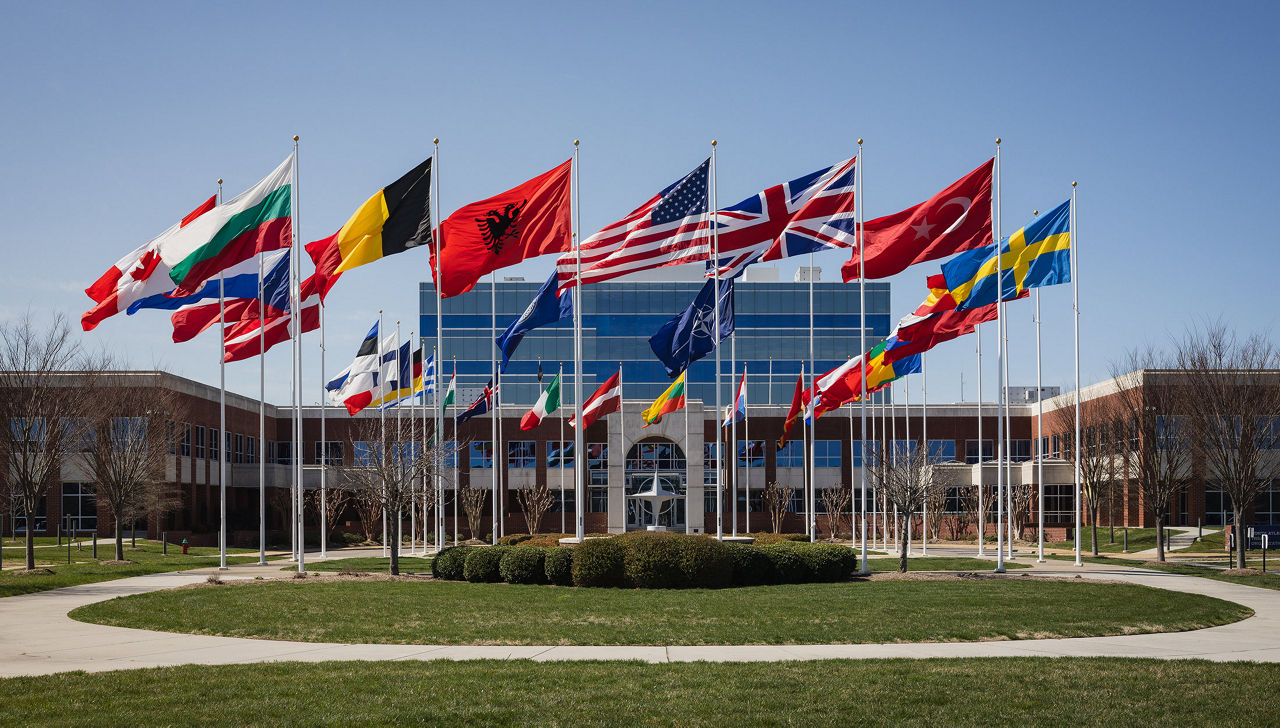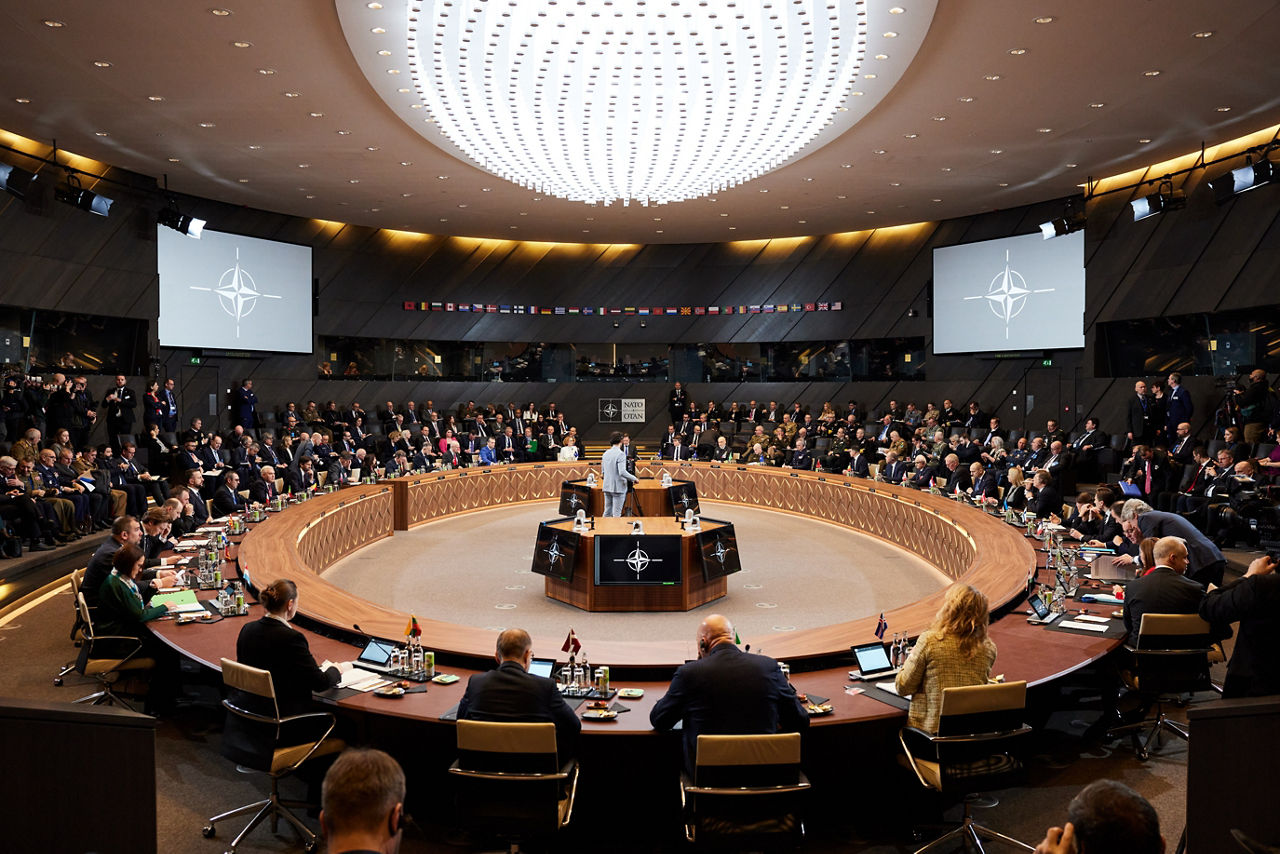Download NATO’s broadcast-quality video content free of charge

Log in
NATO MULTIMEDIA ACCOUNT
Access NATO’s broadcast-quality video content free of charge

Check your inbox and enter verification code
You have successfully created your account
From now on you can download videos from our website
Subscribe to our newsletter
If you would also like to subscribe to the newsletter and receive our latest updates, click on the button below.
Enter the email address you registered with and we will send you a code to reset your password.
Didn't receive a code? Send new Code
The password must be at least 12 characters long, no spaces, include upper/lowercase letters, numbers and symbols.
Your password has been updated
Click the button to return to the page you were on and log in with your new password.
Allied Command Transformation
Updated: 24 September 2024
Tomorrow’s conflicts cannot be won with today’s or yesterday’s skillsets, processes or technology. Allied Command Transformation (ACT) defines the future military context, identifying challenges and opportunities in order to innovate and maintain a warfighting edge. It ensures maximum interoperability; gives structure and priority to NATO forces through defence planning and capability development; applies innovation to leverage ideas, procedures and technologies to the benefit of NATO’s warfare development; and, in all of this, leverages the intellectual horsepower of a large network of industry, academia, military and civilian expertise in nations, in NATO agencies and NATO Centres of Excellence.
- ACT is one of two Strategic Commands at the head of NATO’s military command structure. The other is Allied Command Operations (ACO), which is responsible for the planning and execution of all NATO military operations.
- ACT leads the military adaptation of the Alliance, coordinating national efforts to ensure coherence and assure interoperability, ensuring that NATO has the right Military Instrument of Power to help guarantee the freedom and security of its members.
- It improves the readiness and credibility of NATO’s posture and helps the NATO Command Structure (NCS) to efficiently command, control and support current and future military operations, and provides a secure and stable transition to crisis and conflict, if need be.
- ACT is headed by the Supreme Allied Commander Transformation (SACT), who exercises his responsibilities from headquarters in Norfolk, Virginia, United States.
- SACT is responsible to the Military Committee for the transformation and development of the Alliance to ensure it is capable of meeting the challenges of today and tomorrow. The Military Committee is the senior military authority in NATO and is under the overall political authority of the North Atlantic Council.
- This Strategic Command directs various subordinate Joint Commands and has strong links with education and training facilities, as well as with ministries of defence.
- ACT is also closely connected with the NATO Force Structure (NFS) in general, which consists of forces placed at the Alliance’s disposal by the member countries, along with their associated command and control structures1.
ACT’s role
ACT and ACO form what is called the NATO Command Structure (NCS), whose prime function is first and foremost to provide the command and control needed to anticipate and address threats and, should deterrence fail, enable defensive measures. Ultimately, the NCS plays an essential role in preserving cohesion and solidarity within the Alliance, maintaining and strengthening the vital link between Europe and North America, and promoting the principle of equitable sharing among Allies of the roles, risks and responsibilities, as well as the benefits of collective defence.
Cyber and hybrid warfare, the militarisation of space and the use of artificial intelligence, as well as other emerging security challenges make the transformation of policies, strategies, concepts, doctrine and capabilities essential to be ready for tomorrow. This transformation affects personnel, equipment, doctrine, procedures and technologies, which is called warfare development. ACT, as NATO’s warfare development command, leads the military adaptation of the Alliance and as such, its role is two-fold: first, to enable ACO to efficiently conduct current operations; second, to prepare NATO's future operations. In this context, ACT ensures that NATO's warfare capabilities maintain future relevance, provides an indispensable understanding of the current and future security environment, and contributes to the development of NATO doctrine, concepts and interoperability standards. With its strategic military expertise and innovative approaches to addressing current and future security concerns, ACT contributes to making the NCS fit for purpose and able to fulfil NATO’s three core tasks – collective defence, crisis management and cooperative security.
In sum, ACT identifies challenges and opportunities in order to maintain a warfighting edge; ensures maximum interoperability; gives structure and priority through defence planning and capability development; and applies innovation to all activities. To implement these missions, it is responsible for the following:
- developing concepts that describe new ways of dealing with emerging challenges, harnessing lessons learned, using modelling and simulation to help visualise issues and identifying opportunities and constraints in the adoption of new technologies through experimentation.
- analysing security trends and assessing the inherent risks, threats and opportunities, and investigating alternatives.
- leveraging a vast network of military and civilian expertise in member and partner countries, industry, academia, Joint Commands, NATO agencies, NATO-accredited Centres of Excellence, training and education institutions etc., to ensure a maximum exchange of ideas.
- leading large parts of the NATO Defence Planning Process and making medium to long-term planning. It turns political guidance into capability commitments by all NATO members and frames the path for coherent warfare development for the Alliance.
- defining individual training standards, exchanging information and ensuring the connectivity of equipment and security protocols. It also drives NATO initiatives like Federated Mission Networking, which sets the standards to be adopted to ensure the interoperability of forces for future operations.
- defining and managing new programmes to modernise NATO’s capabilities, and to provide the connecting tissue that enables Allies to operate as a single force. It leads the capability management function across the Alliance and is the capability requirements authority that matches capabilities to future challenges.
- educating and training thousands of army, navy and air force personnel each year and delivering large and small-scale exercises and pre-deployment training.
- supporting ACO to ensure maximum output is generated from the NCS at all levels of a crisis.
More specifically, ACT seeks to meet today’s and tomorrow’s capability requirements; develop operational thinking; capture lessons learned throughout the entire cycle of an operation; facilitate experimentation; deliver pre-deployment training; provide augmentation and enhanced capability development during crises; and analyse and harness emerging security trends and technologies.
ACT’s structure
ACT is comprised of the Norfolk Headquarters and three subordinate entities: the Joint Warfare Centre in Norway, the Joint Force Training Centre in Poland and the Joint Analysis & Lessons Learned Centre in Portugal.
The Headquarters of Allied Command Transformation
The Headquarters of Allied Command Transformation is located in Norfolk, Virginia in the United States. Led by Admiral Pierre Vandier, a French Navy Officer, it acts as a physical symbol of the transatlantic security bond. The Headquarters has a diverse workforce of approximately 750, who are either from the civilian sector, the military (naval, air force, army), or the military police. It is structured into four directorates:
- Strategic Policy and Plans defines the future context, outlines the implications for the Alliance’s military and leads defence planning in response;
- Capability Development is the Alliance’s capability requirements authority that manages the delivery of modern, common-funded capabilities (from the moment a need is identified to when a new capability is entirely produced) and leads the innovation effort within the Alliance;
- Joint Force Development is the engine room of warfare development, applying concepts, lessons, modelling and simulation, operational experimentation and human capital to improve interoperability and enhance capabilities; and
- Resource Management provides the human resources and the financial and business service support to ACT.
Joint Warfare Centre in Stavanger, Norway
The Joint Warfare Centre's (JWC) main task is to train Allied forces at the operational level to ensure they remain interoperable and fully integrated. Its principal mission is the training of the NATO Response Force (NRF) Headquarters' elements and NRF Component Headquarters' elements. In addition, it performs collective staff training for partner countries and new NATO members.
The JWC also seeks to improve NATO's capabilities and interoperability by promoting and conducting NATO's joint and combined experimentation, analysis and doctrine development processes2.
Joint Force Training Centre in Bydgoszcz, Poland
The Joint Force Training Centre (JFTC) focuses on joint and combined training of Allied and partner forces at the tactical level. It focuses, in particular, on the conduct of tactical training to achieve joint interoperability at key interfaces – a critically important area identified during military combat in Afghanistan.
As a priority, the JFTC provides expertise to help NATO Response Force (NRF) joint and component commanders ensure that each NRF rotation achieves a high level of interoperability, flexibility and extensive training so as to be combat-ready at the beginning of a cycle of duty.
The Centre cooperates with national training centres, including Partnership for Peace (PfP) Training Centres and Centres of Excellence to ensure the application of NATO standards and doctrine in combined and joint fields.
Joint Analysis & Lessons Learned Centre in Monsanto, Portugal
The main role of the Joint Analysis & Lessons Learned Centre (JALLC) is to reinforce the process of continuous improvement of concepts, doctrine and capabilities within NATO through the transformation process, based on lessons learned from operations, training, exercises and experimentation. As such, the JALLC conducts the analysis of real-world military operations, training, exercises and NATO Concept Development and Experimentation collective experiments, and is responsible for establishing and maintaining a lessons learned database.
In addition to the Headquarters in Norfolk and the three subordinate entities, ACT also maintains a presence at NATO Headquarters in Brussels, Belgium and at the Pentagon outside Washington D.C., as well as an ACT Staff Element at the ACO Headquarters – Supreme Headquarters Allied Powers Europe, or SHAPE, in Mons, Belgium.
ACT and other entities
There are direct linkages between ACT and entities that are not part of the NCS, such as NATO educational and training facilities, Centres of Excellence and Partner Training and Education Centres. ACT has the overall responsibility for the management and delivery of NATO education and training facilities.
NATO's educational and training facilities (NETFs)
NATO Defense College
At the political-strategic level, the NATO Defense College (NDC) in Rome, Italy is NATO's foremost academic institution. The mission of the NDC is to contribute to the effectiveness and cohesion of the Alliance by developing its role as a major centre of education, outreach and research on transatlantic security issues. Since its founding in 1951, several thousand senior officers, diplomats and other officials have passed through its doors.
NATO School
The NATO School Oberammergau (NSO) in Germany is NATO's premier individual training and education facility at the operational level. The NSO conducts education and individual training in support of current and developing NATO operations, strategy, policy, doctrine and procedures. The NSO works closely with ACT to offer a broad curriculum geared to meet the challenges of a dynamic security environment.
NATO Maritime Interdiction Operational Training Centre
The NATO Maritime Interdiction Operational Training Centre (NMIOTC) in Souda Bay, Greece is a multinationally staffed facility. It conducts combined training for NATO forces to execute surface, sub-surface and aerial surveillance, and special operations activities in support of maritime interdiction operations.
Centres of Excellence and Partner Training and Education Centres
ACT connects NATO-accredited Centres of Excellence (COE) and Partner Training and Education Centres (PTEC) to harness their capability in order to enhance that of the Alliance’s.
COEs are nationally or multi-nationally funded institutions that train and educate leaders and specialists from NATO member and partner countries, assist in doctrine development, identify lessons learned, improve interoperability and capabilities, and test and validate concepts through experimentation. Coordinated by ACT, COEs are considered to be international military organisations. Although not part of the NCS, they are part of a wider framework supporting NATO command arrangements. Designed to complement the Alliance's current resources, COEs cover a wide variety of areas, with each one focusing on a specific field of expertise to enhance NATO capabilities.
The Partnership Training and Education Centres (PTEC) are nationally or multi-nationally sponsored education and training institutions, which are united under a single concept that is endorsed by the North Atlantic Council and recognised by NATO.
Evolution
Before 2002, the two Strategic Commands were Allied Command Europe (ACE), established in 1951, and Allied Command Atlantic (ACLANT), created a year later in 1952.
ACE, together with ACLANT, were streamlined at the end of the Cold War reducing the NATO Command Structure from 78 headquarters to 20. However, the two overarching Strategic Commanders (SC) were maintained, one for the Atlantic area and one for Europe.
During the 2002 Prague Summit, a decision was made to reorganise the NATO Command Structure and make it leaner and more efficient. Additionally, Alliance thinking fundamentally shifted: the NATO Command Structure was to be based on functionality rather than geography. The former Allied Command Europe (ACE) became the Allied Command Operations (ACO), responsible for all Alliance operations, including the maritime operations previously undertaken by Allied Command Atlantic (ACLANT). As such, one strategic command was focused on NATO’s operations – Allied Command Operations with its headquarters in SHAPE – and the other on transforming NATO – Allied Command Transformation with its Headquarters SACT.
The NATO Command Structure was reviewed once more in June 2011 as part of a wider process of reform, not only to optimise the structure but to include new tasks derived from the 2010 Strategic Concept. The two strategic commands were maintained, as well as the Alliance’s levels of ambition, which is the ability of the Alliance to manage two major joint operations and six small joint operations, if required.
In June 2018, NATO Defence Ministers agreed to move forward with an adapted NATO Command Structure (NCS-A) and the Detailed Implementation Plans (DIPlans). Both Strategic Commanders immediately initiated the new structures and capabilities, with ACO as the warfighting command and ACT as the warfare development command.
1. Forces from the NATO Force Structure are available for NATO operations in accordance with predetermined readiness criteria and with rules of deployment and transfer of authority to NATO command that can vary from country to country.
2. Joint forces are forces from two or more military services (for instance, land, maritime or air) working under a single command; combined forces are forces from different countries working under a single command.






